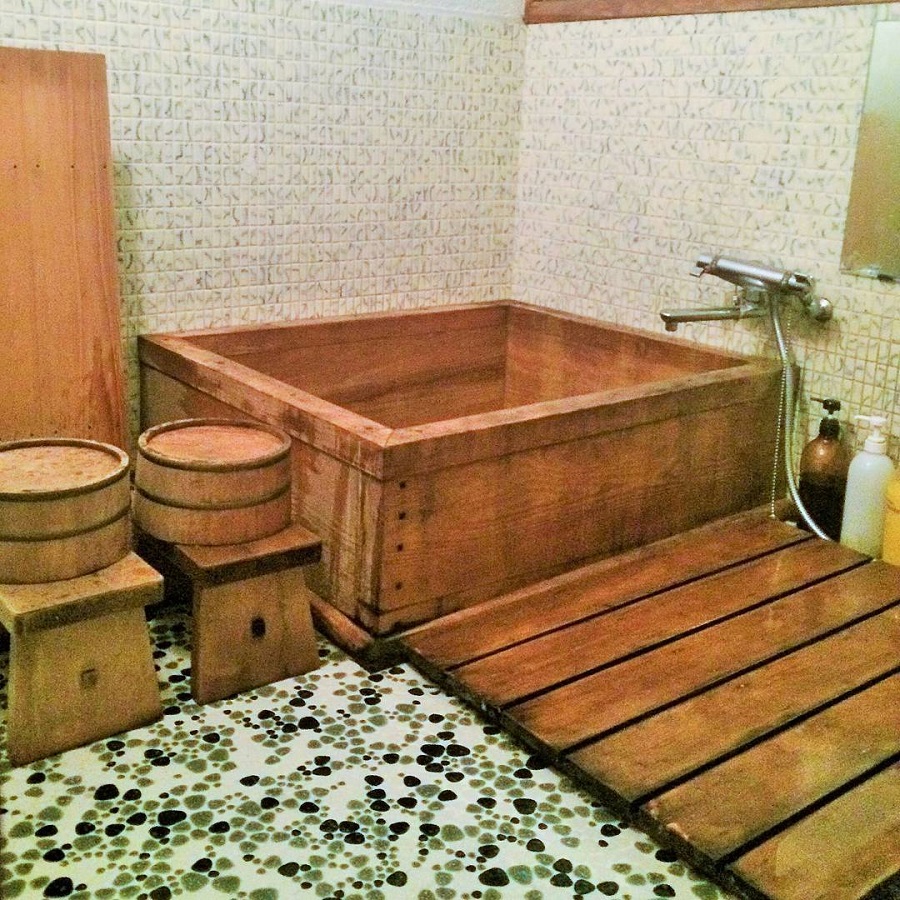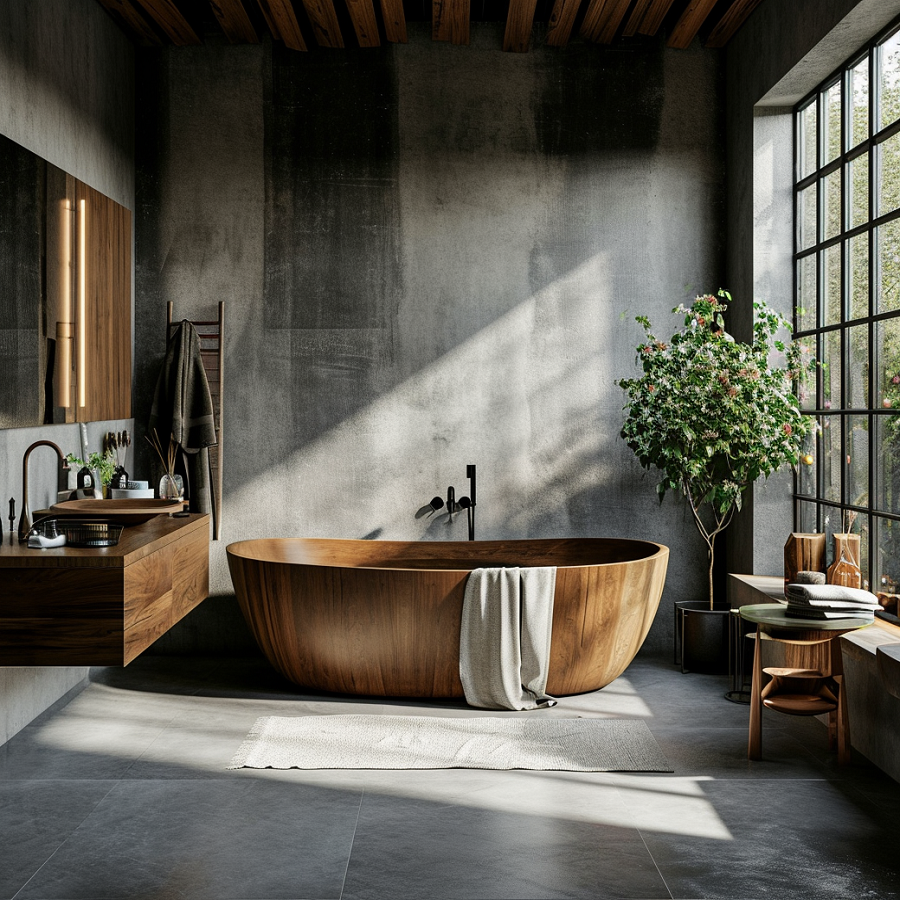Introduction to Japanese Style Bathrooms
Japanese style bathrooms blend tranquility with nature, offering a unique atmosphere of serenity. Rooted in centuries-old traditions, these spaces focus on minimalism, functionality, and a close connection to natural elements.
Influences and Philosophy Behind the Design
Japanese bathroom design is deeply influenced by the country’s cultural emphasis on cleanliness, simplicity, and harmony with nature. These principles shape a bathroom that’s not just a place to cleanse the body, but also a space for calming the mind. The design favors clean lines, natural materials, and functional features, creating a peaceful retreat within the home.

Key Elements of a Japanese Style Bathroom
Creating a Japanese style bathroom involves key elements that evoke a sense of peace and connection to nature.
Deep Soaking Tubs: The Ofuro Experience
Central to the Japanese bath experience is the ‘ofuro’, a deep soaking tub designed for full-body immersion. These tubs offer a place to unwind, reflecting a key part of Japanese culture.
Natural Materials: Wood, Stone, and Bamboo
Japanese bathrooms use natural materials like wood, stone, and bamboo. These elements bring the outdoors inside, adding warmth and texture.
Color Palette: Embracing Earthy Tones
A color scheme with earthy tones, like beiges and greens, complements the natural materials. It helps create a calm and soothing space.
Minimalist Approach for Maximum Serenity
Simplicity is at the heart of Japanese design. A minimalist setting clears the mind, helping to maintain focus and tranquility.
Designing Your Space: Practical Aspects
When undertaking the creation of a Japanese style bathroom, the layout and design aspects are crucial. Careful planning ensures that regardless of the bathroom’s size, the space embodies the calm and nature-centric essence of a Japanese spa.
Layout Considerations for Small and Large Bathrooms
Finding balance between function and form is key in bathrooms, large or small. In small spaces, using wall-mounted fixtures and sliding doors maximizes area. Larger bathrooms benefit from distinct zones for soaking and showering, drawing inspiration from traditional Japanese baths. Ensure every element serves a purpose, adhering to minimalist principles.
Incorporating Water Features for a Soothing Atmosphere
Water features, like a babbling bamboo fountain, add a meditative soundtrack that heightens the peaceful ambiance. Even a small water feature can have a significant impact, bringing the harmonious sound of nature inside. Choose a design that suits your aesthetic and complements the natural tranquility.
Lighting: Creating Softness and Warmth
Lighting in a Japanese style bathroom should create a subdued, warm atmosphere. Opt for low-hanging pendants or recessed lights with dimmer switches. Incorporating frosted glass shades or paper lanterns curates a diffuse glow. Position lights thoughtfully to cast a gentle illumination, promoting a sense of calm.

Cultural Touches and Modern Amenities
Creating a Japanese style bathroom means blending culture and modernity. Deeply rooted traditions unite with cutting-edge conveniences for a unique washroom experience.
Combining Traditional and Modern Bathroom Features
Merge old and new for a timeless space. Think wooden bath stools beside high-tech heated toilets. Imagine classic stone basins with touchless faucets. It’s a mix that honors heritage while embracing progress.
Smart Technology in Japanese Bathrooms
High-tech meets high tranquility. Automated bidets offer cleansing and comfort. Waterproof speakers play soothing sounds. Smart mirrors display the time and weather as you groom.
Personalizing with Artistic Accents
Make your space yours with special touches. Hang a scroll with peaceful kanji characters. Display a vase with delicate cherry blossoms. Add a hand-painted screen for privacy and beauty. Personal items spark joy in your serene retreat.
Maximizing Space: Storage and Organization
Creating space in a Japanese style bathroom is essential for maintaining a minimalist and serene environment. It’s crucial to find storage solutions that keep your space clutter-free and harmonious.
Clever Space-Saving Solutions
To make the most of every inch, consider wall-mounted cabinets and floating shelves. They provide storage without cluttering the floor. Corner shelves utilize overlooked spaces. A mirrored medicine cabinet doubles as storage and a vanity mirror.
Efficient and Stylish Storage Options
Choose multi-functional furniture, like a vanity with built-in drawers. Baskets made of natural materials can hide toiletries while adding to the aesthetic. A tall, narrow cabinet offers ample storage vertically. Sliding doors on cabinets save space. Opt for furniture pieces with a slim profile to maintain a sleek look.
Bringing Nature Indoors
Bringing nature inside is fundamental in Japanese style bathrooms. As you integrate calming elements from the outdoors, the space becomes a living sanctuary. Let’s delve into how plants and air quality play vital roles.
The Role of Plants in Japanese Style Bathrooms
In Japanese style bathrooms, plants are more than decor. They cleanse the air and add tranquility. Ferns, bamboo, and peace lilies are popular choices that thrive in high humidity. Position plants strategically for a touch of greenery and balance. But, be mindful to pick ones that require minimal sunlight.
Choosing the right container is also crucial. Go for natural materials like ceramic or stone pots. They complement the Zen aesthetic and last long in moist conditions. Remember to keep plant maintenance at ease. Stick to varieties that need less tending, so your bathroom stays a Zen retreat.

Natural Ventilation and Indoor Air Quality
In Japanese style bathrooms, fresh air is essential. It ensures a comfortable environment and prevents moisture problems. Effective ventilation comes in several forms. Windows that open are ideal for letting in fresh air. But when that’s not possible, consider an exhaust fan. Make sure it’s quiet and powerful.
Small changes can also boost air quality. Choose materials that resist mold and dampness. Options like teak wood or cedar are optimal for humid settings. They’re naturally resistant to decay. Plus, a dehumidifier can help in bathrooms without windows, controlling moisture and keeping the air fresh.
By integrating plants and proper ventilation, Japanese style bathrooms become healthful spaces. They’re perfect for rejuvenation and offer a sensory experience close to nature. These touches not only follow tradition but also cater to a modern, eco-conscious lifestyle.
Conclusion: Achieving a Balanced and Peaceful Bathroom Retreat
Creating a Japanese style bathroom provides a sanctuary that nurtures peace and balance. This unique design reflects a profound respect for nature, simplicity, and functionality. Here are some final thoughts to guide your own tranquil bathroom retreat:
Harmonize with Nature
Incorporate elements of nature to foster tranquility. Use materials like wood, stone, and bamboo to connect with the natural world.
Keep It Simple
Embrace minimalism by decluttering and selecting simple, elegant fixtures. A minimalist space invites calm and clarity.
Soak and Soothe
Include a deep soaking tub for a therapeutic escape. The traditional ‘ofuro’ enhances relaxation and well-being.
Choose Earth Tones
Select colors that soothe the senses, like soft greens and warm beiges. They create a serene backdrop for your retreat.
Add Personal Touches
Introduce items that hold meaning for you, such as calming artwork or a favorite plant, to make the space uniquely yours.
Optimize Space
Make the most of your bathroom area with smart storage solutions. Use wall-mounted or floating designs to save space without sacrificing style.
Breathe Easy
Ensure good ventilation to maintain air quality. Use moisture-resistant materials and consider a dehumidifier for dampness control.
With these considerations in mind, your Japanese style bathroom will become a harmonious oasis. It will be a space where each element is carefully chosen to create an environment of balance, peace, and introspection.


